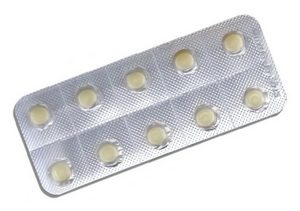 Anafranil is a drug from the group of tricyclic antidepressants. The primary active substance of the drug is clomipramine, which inhibits the reuptake of serotonin and norepinephrine in the synaptic cleft, thereby increasing their concentration. Serotonin is one of the most important mediators in the central nervous system, and its deficiency leads to the development of depressive disorders, psychogenic pain syndrome, and certain other conditions.
Anafranil is a drug from the group of tricyclic antidepressants. The primary active substance of the drug is clomipramine, which inhibits the reuptake of serotonin and norepinephrine in the synaptic cleft, thereby increasing their concentration. Serotonin is one of the most important mediators in the central nervous system, and its deficiency leads to the development of depressive disorders, psychogenic pain syndrome, and certain other conditions.
Composition and form of release
Anafranil is available in tablets containing 25 mg or 100 mg of clomipramine. In addition to the tablet form, there is also an injection form. In this manner, the drug is released in ampoules of 2 mL containing 25 mg of clomipramine. The solution is indicated for both intramuscular and intravenous injections.
Indications for Anafranil
Anafranil has a wide range of indications for use. In adult patients, it is used in the following cases:
- Depressive disorders of any origin
- Depression syndrome
- Obsessive-compulsive disorder
- Psychogenic and neuropathic pain syndromes
- Cataplexy in narcolepsy
- Fears and panic attacks
 The use of the drug in children is limited and should be done in the case of the following:
The use of the drug in children is limited and should be done in the case of the following:
- Obsessive-compulsive disorder
- Enuresis in children older than five years of age
Contraindications for Anafranil
Anafranil has the following contraindications to its use:
- Increased sensitivity to clomipramine and other components of the drug
- Increased sensitivity to tricyclic antidepressants from the dibenzazepine subgroup
- Joint administration with antidepressants from the group of monoamine oxidase inhibitors
- Myocardial infarction
- Prolongation of the QT interval on the electrocardiogram
The drug is not officially contraindicated for use in pregnant women and children, but its intake during pregnancy, breastfeeding, and in children younger than five years of age is not recommended due to the lack of data from drug safety studies conducted involving these categories of patients.
Side effects of clomipramine
According to the instructions for use, clomipramine can cause serious side effects, as follows:
- Nervous system: fatigue, sleep disturbances, anxiety, increased appetite, irritability, dizziness, and headache
- Endocrine system: weight gain, erectile dysfunction, decreased sexual desire, galactorrhea, and increase in the size of the mammary glands
- Cardiovascular system: sinus tachycardia, palpitation, orthostatic hypotension, and arterial hypertension
- Digestive system: nausea, diarrhea or constipation, decreased appetite, increased level of liver enzymes, and toxic hepatitis
- Skin: allergic manifestations, itchy skin, swelling, and baldness
- Immune system: allergic pneumonitis and other manifestations of allergic reactions
- Hematopoiesis system: eosinophilia and a decrease in the level of thrombocytes
- Sense organs: a perversion of taste and a noise in the ears
- Other reactions: increased sweating, urination disorders, and flushing of blood to the face
How to take Anafranil
Before beginning to take Anafranil, one needs to check their blood potassium levels and eliminate hypokalemia if it is present.
The daily dose is divided into two or three doses. For example, a daily dose of 75 mg can be taken in three divided doses (i.e., 25 mg three times a day).
Treatment in each case starts with a minimum dosage, with a continuous (once per week) increase by 25 mg to achieve an average therapeutic dose. In the case of a low clinical effect, the dose may be increased to the maximum. When the condition is stabilized, the dosage of the drug should be gradually decreased.
